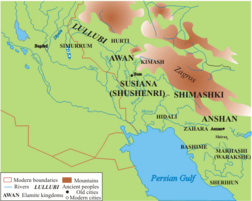Awan (ancient city) facts for kids

Awan was an ancient city or region in a place called Elam. Elam was located in what is now western Iran. Awan is often mentioned alongside other important cities like Susa and Anshan. It played a big role in the early history of Mesopotamia, often having conflicts with the powerful cities of Sumer. The name "Awan" comes from the Sumerian language, written in cuneiform as a-wa-anki, which means "Country of Awan".
Where Was Awan Located?
The exact spot where the city of Awan was located is still a mystery to archaeologists. They haven't found its ruins yet. However, we know it was likely close to other ancient cities like Susa. This idea comes from old writings. For example, a record from King Ibbi-Sin of the Ur III empire mentions him fighting against Susa, Adamdun, and Awan all at once. This suggests these places were all in the same general area.
Awan's History
A group of rulers known as the Awan Dynasty was named after this city. This dynasty was founded by a ruler named Peli. Because of this, it is sometimes called "the dynasty of Peli."
According to the Sumerian King List, which is an ancient document listing kings, the Awan Dynasty brought an end to the First Dynasty of Ur around 2450 BCE. After this, three kings from Awan ruled over the southern parts of Sumer.
Awan and the Akkadian Empire
Later, around 2300-2200 BCE, the powerful Akkadian Empire fought many battles against Awan. Famous Akkadian rulers like Sargon of Akkad and Rimush claimed victories over Awan.
However, one Akkadian king, Naram-Sin, actually signed an agreement with Khita. Khita was the ninth king of Awan at that time.
Awan managed to regain its freedom from the Akkadians during the time of King Shar-Kali-Sharri. But eventually, the Awan Dynasty came to an end. Its last king was Kutik-Inshushinak. After this, the region came under the control of the Third Dynasty of Ur, around 2100-2000 BCE.
After these events, the name "Awan" disappears from historical records.
See also
- Cities of the ancient Near East
- List of Mesopotamian dynasties



